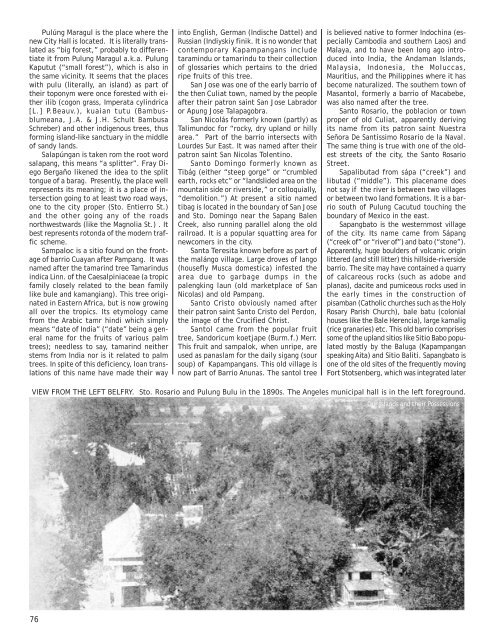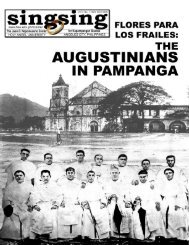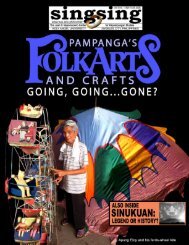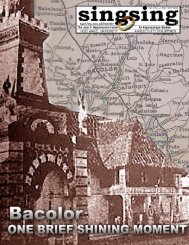Download PDF - Holy Angel University
Download PDF - Holy Angel University
Download PDF - Holy Angel University
You also want an ePaper? Increase the reach of your titles
YUMPU automatically turns print PDFs into web optimized ePapers that Google loves.
Pulúng Maragul is the place where the<br />
new City Hall is located. It is literally translated<br />
as “big forest,” probably to differentiate<br />
it from Pulung Maragul a.k.a. Pulung<br />
Kaputut (“small forest”), which is also in<br />
the same vicinity. It seems that the places<br />
with pulu (literally, an island) as part of<br />
their toponym were once forested with either<br />
ilib (cogon grass, Imperata cylindrica<br />
[L.] P.Beauv.), kuaian tutu (Bambusblumeana,<br />
J.A. & J.H. Schult Bambusa<br />
Schreber) and other indigenous trees, thus<br />
forming island-like sanctuary in the middle<br />
of sandy lands.<br />
Salapúngan is taken rom the root word<br />
salapang, this means “a splitter”. Fray Diego<br />
Bergaño likened the idea to the split<br />
tongue of a barag. Presently, the place well<br />
represents its meaning; it is a place of intersection<br />
going to at least two road ways,<br />
one to the city proper (Sto. Entierro St.)<br />
and the other going any of the roads<br />
northwestwards (like the Magnolia St.) . It<br />
best represents rotonda of the modern traffic<br />
scheme.<br />
Sampaloc is a sitio found on the frontage<br />
of barrio Cuayan after Pampang. It was<br />
named after the tamarind tree Tamarindus<br />
indica Linn. of the Caesalpiniaceae (a tropic<br />
family closely related to the bean family<br />
like bule and kamangiang). This tree originated<br />
in Eastern Africa, but is now growing<br />
all over the tropics. Its etymology came<br />
from the Arabic tamr hindi which simply<br />
means “date of India” (“date” being a general<br />
name for the fruits of various palm<br />
trees); needless to say, tamarind neither<br />
stems from India nor is it related to palm<br />
trees. In spite of this deficiency, loan translations<br />
of this name have made their way<br />
VIEW FROM THE LEFT BELFRY. Sto. Rosario and Pulung Bulu in the 1890s. The <strong>Angel</strong>es municipal hall is in the left foreground.<br />
76<br />
into English, German (Indische Dattel) and<br />
Russian (Indiyskiy finik. It is no wonder that<br />
contemporary Kapampangans include<br />
taramindu or tamarindu to their collection<br />
of glossaries which pertains to the dried<br />
ripe fruits of this tree.<br />
San Jose was one of the early barrio of<br />
the then Culiat town, named by the people<br />
after their patron saint San Jose Labrador<br />
or Apung Jose Talapagobra.<br />
San Nicolás formerly known (partly) as<br />
Talimundoc for “rocky, dry upland or hilly<br />
area.” Part of the barrio intersects with<br />
Lourdes Sur East. It was named after their<br />
patron saint San Nicolas Tolentino.<br />
Santo Domingo formerly known as<br />
Tibág (either “steep gorge” or “crumbled<br />
earth, rocks etc” or “landslided area on the<br />
mountain side or riverside,” or colloquially,<br />
“demolition.”) At present a sitio named<br />
tibag is located in the boundary of San Jose<br />
and Sto. Domingo near the Sapang Balen<br />
Creek, also running parallel along the old<br />
railroad. It is a popular squatting area for<br />
newcomers in the city.<br />
Santa Teresita known before as part of<br />
the malángo village. Large droves of lango<br />
(housefly Musca domestica) infested the<br />
area due to garbage dumps in the<br />
palengking laun (old marketplace of San<br />
Nicolas) and old Pampang.<br />
Santo Cristo obviously named after<br />
their patron saint Santo Cristo del Perdon,<br />
the image of the Crucified Christ.<br />
Santol came from the popular fruit<br />
tree, Sandoricum koetjape (Burm.f.) Merr.<br />
This fruit and sampalok, when unripe, are<br />
used as panaslam for the daily sigang (sour<br />
soup) of Kapampangans. This old village is<br />
now part of Barrio Anunas. The santol tree<br />
is believed native to former Indochina (especially<br />
Cambodia and southern Laos) and<br />
Malaya, and to have been long ago introduced<br />
into India, the Andaman Islands,<br />
Malaysia, Indonesia, the Moluccas,<br />
Mauritius, and the Philippines where it has<br />
become naturalized. The southern town of<br />
Masantol, formerly a barrio of Macabebe,<br />
was also named after the tree.<br />
Santo Rosario, the poblacion or town<br />
proper of old Culiat, apparently deriving<br />
its name from its patron saint Nuestra<br />
Señora De Santissimo Rosario de la Naval.<br />
The same thing is true with one of the oldest<br />
streets of the city, the Santo Rosario<br />
Street.<br />
Sapalibutad from sápa (“creek”) and<br />
libutad (“middle”). This placename does<br />
not say if the river is between two villages<br />
or between two land formations. It is a barrio<br />
south of Pulung Cacutud touching the<br />
boundary of Mexico in the east.<br />
Sapangbato is the westernmost village<br />
of the city. Its name came from Sápang<br />
(“creek of” or “river of”) and bato (“stone”).<br />
Apparently, huge boulders of volcanic origin<br />
littered (and still litter) this hillside-riverside<br />
barrio. The site may have contained a quarry<br />
of calcareous rocks (such as adobe and<br />
planas), dacite and pumiceous rocks used in<br />
the early times in the construction of<br />
pisamban (Catholic churches such as the <strong>Holy</strong><br />
Rosary Parish Church), bale batu (colonial<br />
houses like the Bale Herencia), large kamalig<br />
(rice granaries) etc. This old barrio comprises<br />
some of the upland sitios like Sitio Babo populated<br />
mostly by the Baluga (Kapampangan<br />
speaking Aita) and Sitio Baliti. Sapangbato is<br />
one of the old sites of the frequently moving<br />
Fort Stotsenberg, which was integrated later<br />
Our Islands and their Possessions








